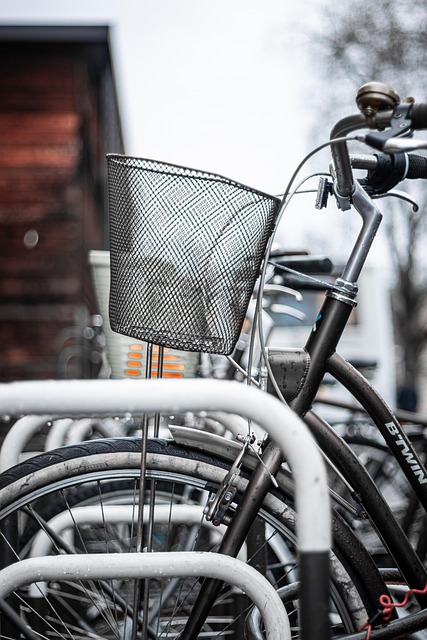Eugene, Oregon, prioritizes inclusive transport with a comprehensive system designed for accessibility. Features include low-floor buses, ramp access, audible announcements, and tactile aids. Community feedback and audits ensure continuous improvement. Dedicated bike infrastructure caters to all cyclists. Technology advances, like ride-sharing apps and GPS systems, enhance access. Public engagement ensures solutions meet diverse needs, making Eugene a leader in inclusive urban mobility.
Eugene, Oregon, boasts an impressive commitment to accessible transport infrastructure, fostering a more inclusive city for all residents and visitors. This article explores various facets of Eugene’s transportation accessibility, from evaluating current transit systems to implementing best practices in design and technology. We delve into the impact of pedestrian crossings, bike infrastructure, community engagement, and innovative tech solutions that enhance mobility for individuals with disabilities, ultimately shaping a more inclusive urban environment. Discover how Eugene leads the way in promoting accessible transport.
- Evaluating Current Accessibility in Eugene's Transit System
- Best Practices for Designing Inclusive Bus Stops and Stations
- The Impact of Accessible Pedestrian Crossings on Community Mobility
- Encouraging Bike Infrastructure for All Abilities in Downtown Eugene
- Technology Enhancing Transportation Access for Individuals with Disabilities
- Community Engagement Strategies for More Inclusive Transport Planning
Evaluating Current Accessibility in Eugene's Transit System

Eugene, Oregon, boasts an extensive transit system designed to be inclusive and accessible to all residents and visitors. However, evaluating its current accessibility is crucial to understanding the progress made and identifying areas for improvement in providing an inclusive transport network. The city’s public transportation options, including buses and light rail services, are equipped with features such as low-floor entry points, ramp access, and audible announcements to cater to individuals with disabilities.
Regular audits and feedback from the community play a vital role in gauging the effectiveness of these accessibility measures. By considering the experiences of people with diverse mobility needs, from seniors and individuals using wheelchairs to those with visual impairments, city planners can make informed decisions to enhance the inclusivity of Eugene’s transport infrastructure. This ongoing assessment ensures that the transit system evolves to meet the changing demands of a diverse population, fostering a more accessible and welcoming environment for everyone in the community.
Best Practices for Designing Inclusive Bus Stops and Stations

When designing bus stops and stations in Eugene, Oregon, with inclusivity in mind, several best practices should be implemented to ensure all residents can access and utilize public transport easily. One key aspect is providing adequate space for wheelchairs and mobility aids, including ramped entrances and low-floor buses that facilitate seamless boarding and alighting. Additionally, well-lit and visually distinct stops with clear signage and tactile paving aids help guide users with visual or cognitive impairments.
Another important consideration is positioning stop signs and shelters at a comfortable height for all passengers while offering shelter from adverse weather conditions. Integrating accessible features such as audible announcements and real-time arrival information on digital displays benefits blind or low-vision passengers, enhancing their overall experience. Design should also account for accessibility during emergency situations, ensuring clear exit routes and easy access to assistance.
The Impact of Accessible Pedestrian Crossings on Community Mobility

Accessible pedestrian crossings play a pivotal role in enhancing community mobility, particularly for individuals with disabilities or limited mobility in Eugene, Oregon. These crossings, designed to accommodate all users, ensure that everyone can navigate the city safely and independently. By implementing inclusive transport solutions, such as tactile paving, audible signals, and well-lit paths, the city promotes a more accessible environment, fostering greater participation in community activities and daily routines.
The impact is twofold: it empowers residents with disabilities to move around freely, increasing their independence and quality of life, while also encouraging non-disabled individuals to adopt more inclusive habits, creating a more cohesive and mobile community overall. This shift towards accessible transport infrastructure not only benefits individuals but also contributes to a vibrant, livable city that welcomes all its citizens.
Encouraging Bike Infrastructure for All Abilities in Downtown Eugene

Eugene, Oregon, is making strides towards accessible transport infrastructure that caters to all abilities. One notable initiative is the encouragement and expansion of bike infrastructure throughout downtown. This includes dedicated bike lanes, smooth surfaces, and inclusive design elements that accommodate both able-bodied cyclists and those using mobility aids. The city has recognized the benefits of active transportation in reducing traffic congestion and promoting a healthier lifestyle for residents.
By prioritizing bike accessibility, Eugene is fostering an inclusive transport system that resonates with its diverse community. This approach not only encourages more people to opt for sustainable modes of travel but also enhances overall mobility and connectivity within the downtown area. The commitment to creating an environment where everyone can move around freely and independently is a key aspect of Eugene’s vision for inclusive transport in Oregon.
Technology Enhancing Transportation Access for Individuals with Disabilities

In recent years, technology has played a pivotal role in enhancing transportation access for individuals with disabilities in Eugene, Oregon. Innovative solutions like accessible ride-sharing apps and advanced navigation systems powered by GPS have made commuting more inclusive. These digital tools not only provide real-time updates on bus schedules and route changes but also offer voice guidance, making it easier for visually impaired passengers to navigate unfamiliar routes safely.
Additionally, autonomous vehicles and specialized adaptive equipment are transforming public transportation in Eugene. Low-floor buses equipped with ramp access and dedicated spaces for wheelchairs have become the norm, ensuring seamless boarding and alighting for people with mobility challenges. These technological advancements, combined with a growing awareness of inclusivity, are paving the way for a more accessible transport infrastructure that caters to the diverse needs of all residents in Eugene, Oregon.
Community Engagement Strategies for More Inclusive Transport Planning

In the pursuit of an inclusive transport system in Eugene, Oregon, community engagement plays a pivotal role. Effective strategies ensure that diverse populations, including people with disabilities, older adults, and low-income communities, have a voice in shaping their transportation future. Public forums, workshops, and surveys can facilitate dialogue, gather insights, and address specific needs. By actively involving residents, decision-makers can create solutions tailored to the unique challenges of each community, fostering a more accessible and user-friendly transport infrastructure for all.
These engagement tactics not only enhance accessibility but also promote social integration and equity. They empower marginalized groups to envision and advocate for their ideal transportation network, leading to policies and developments that prioritize inclusivity. Through this collaborative process, Eugene can become a model city, showcasing how community participation transforms urban mobility into an experience accessible and appreciated by everyone.
